Top Growth Initiatives to Scale Your Business (+Examples)
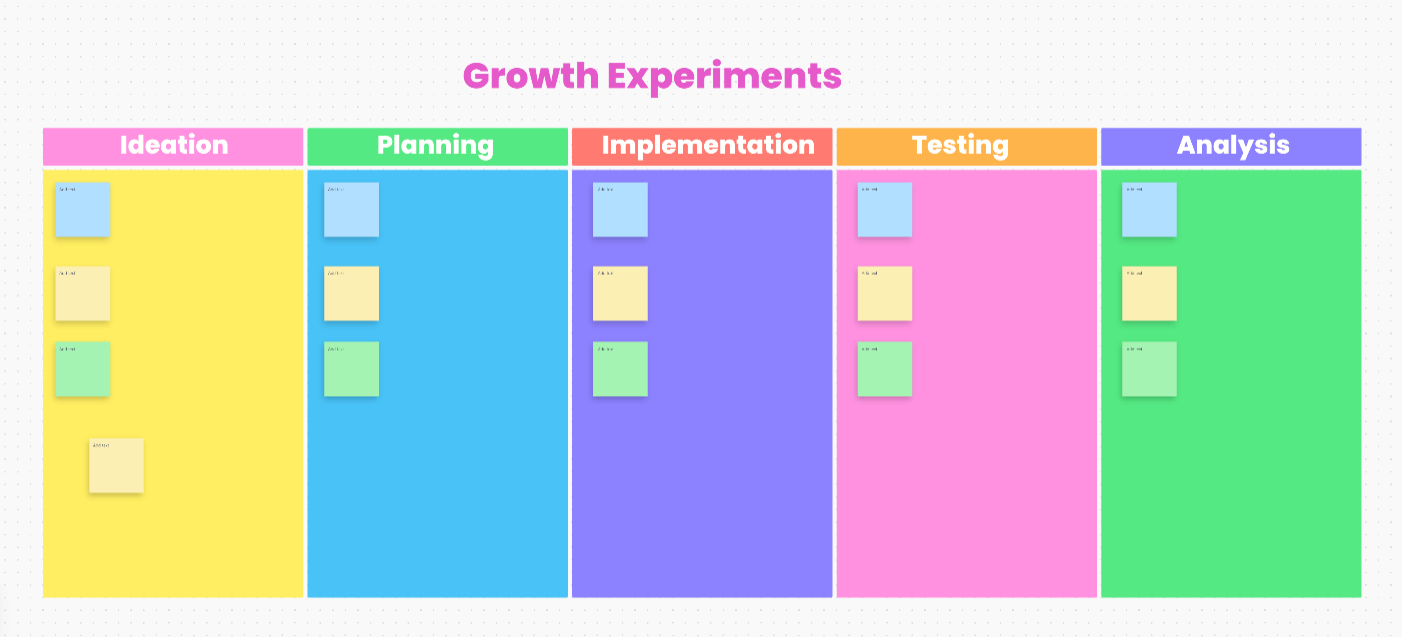
Sorry, there were no results found for “”
Sorry, there were no results found for “”
Sorry, there were no results found for “”

Did you know that Airbnb almost didn’t make it?
It seemed like the company’s growth had hit a wall in its early days. However, a simple, strategic business growth initiative that involved posting high-quality photos helped transform a struggling startup into a global giant.
What’s the equivalent of Airbnb’s photo strategy for your business? Should you expand into new markets, automate operations, or double down on partnerships? The wrong initiative can drain resources, while the right one can unlock exponential growth.
In this guide, we’ll discuss proven strategies that businesses have used to scale successfully, using real-world examples to illustrate how they did it.
👀 Did You Know? Only 33% of business leaders feel highly confident in their company’s growth over the next year. That means the majority are unsure of the best path forward.
Growth initiatives are targeted actions designed to expand a business’s reach, revenue, or market position. Unlike general business strategies—which focus on maintaining operations, improving efficiency, or sustaining profitability—growth initiatives are proactive measures that drive measurable expansion.
Without a deliberate and detailed growth strategy, businesses risk stagnation. They end up relying on past successes rather than building toward future potential.
➡️ A well-executed growth initiative can help a company:
While both growth initiatives and regular business strategies contribute to a company’s success, they serve different purposes:
| Aspect | Growth initiatives | Regular business strategies |
| Purpose | Focused on expansion, revenue growth, and market reach | Ensures stability, efficiency, and sustainability |
| Timeframe | Short- to mid-term, often experimental | Long-term, foundational to the business |
| Risk level | Higher risk, but with potential for high rewards | Lower risk, focused on maintaining operations |
| Examples | Launching a new product, entering a new market, acquiring a competitor | Cost-cutting, process optimization, employee training |
Whether you’re mapping out new revenue streams, optimizing customer retention strategies, or testing product innovations, the ClickUp Growth Experiments Whiteboard Template makes it easier to visualize growth opportunities and turn them into actionable steps.
With pre-built visual templates like this, your team gets a structured way to experiment with new ideas.
Here are some of the most effective growth strategy examples for expanding your business.
Expanding into new markets can open up massive growth opportunities by reaching more customers. This could mean targeting a new location, appealing to a different audience, or adapting your offerings to fit a specific market need.
How you can apply this to facilitate growth:
💡 Pro Tip: Before entering a new market, test demand with a small-scale launch or pilot program to minimize risk.
For PLG companies, their products or services are their biggest assets. But even those need to evolve. Innovating or improving your existing products and offerings with the right strategies can help you stay competitive, attract new customers, and increase revenue.
How successful companies apply this:
💡 Pro Tip: Use customer surveys and competitor analysis to validate demand before investing in product development.
Technology isn’t just a nice-to-have—it’s a growth driver. Automating processes, using AI, and embracing digital tools can help speed up operations, reduce costs, and enhance customer experience.
Here’s how you can apply this:
💡 Pro Tip: Start with small automation projects that provide quick wins before expanding to larger digital transformation efforts. Here’s a quick video guide to help you implement workflow automation for everyday business processes:
📮 ClickUp Insight: 45% of workers have thought about using automation, but haven’t taken the leap.
Factors like limited time, uncertainty about the best tools, and overwhelming choices can hold people back from taking the first step toward automation. ⚒️
With its easy-to-build AI agents and natural language-based commands, ClickUp makes it easy to get started with automations. From auto-assigning tasks to AI-generated project summaries, you can unlock powerful automation and even build custom AI agents in minutes—minus the learning curve.
💫 Real Results: QubicaAMF cut reporting time by 40% using ClickUp’s dynamic dashboards and automated charts, transforming hours of manual work into real-time insights.
Your customers are your most valuable asset. A strong customer experience can lead to repeat purchases, referrals, and long-term loyalty—all of which fuel growth.
What you can do to apply this:
Sometimes, teaming up is the fastest way to grow. Strategic partnerships with other businesses can help you expand your audience, share resources, and boost credibility.
How you can apply this:
💡 Pro Tip: Ensure partnerships align with your brand values and audience to maximize impact.
Beyond getting your name out, marketing also means working on getting results.
Performance-driven strategies focus on ROI, market share, data analysis, and continuous optimization to drive real business growth initiatives.
How you can apply this:
👀 Did You Know? Businesses that publish nine plus blog posts per month see a 20.1% boost in monthly organic traffic, 3.6 times the growth of those posting only one to four times.
💡 Pro Tip: Track key marketing metrics like customer acquisition cost (CAC) and lifetime value (LTV) to measure the effectiveness of your campaigns.
A great product and solid marketing won’t grow your business without a strong sales strategy. Optimizing your sales process can help you convert more leads, close more deals, and maximize your revenue growth rate.
How you can apply this:
💡 Pro Tip: Train your sales team to focus on consultative selling—helping customers solve problems rather than just pushing a product. This builds trust and leads to higher conversions.
Here are real-world case studies of companies that implemented smart growth initiatives and saw significant results.
⚠️ The challenge: Dropbox, the cloud storage and file sharing platform, faced a common problem—acquiring new users in a crowded market without spending heavily on ads.
🧠 The strategy: To address this, Dropbox implemented a double-sided referral program. They offered the referrer and the referred friend an additional 500 MB of free storage space. This incentivized existing users to invite new customers, creating a viral growth loop that boosted user acquisition.
🎯 The result: This growth-hacking strategy led to a 3,900% growth in Dropbox’s user base over 15 months, expanding from 100,000 to 4 million users.
✅ Key takeaway: Implementing a well-designed referral program can be a cost-effective and powerful method for companies to acquire new users rapidly.
⚠️ The challenge: Netflix began as a DVD rental service but faced challenges with growth as the market shifted towards digital consumption.
🧠 The strategy: Netflix embraced digital transformation by introducing streaming services and investing in original content, starting with House of Cards in 2013.
🎯 The result: Netflix transformed into a global streaming leader, redefining media consumption and setting industry standards. It’s one of the most successful streaming companies today.
✅ Key takeaway: Adapting to digital innovation and focusing on customer-centric strategies can pave the path to industry leadership.
🧠 Fun Fact: Brands with a clear purpose can see up to 175% growth in brand value over 12 years.
⚠️ The challenge: Coffee chain Starbucks aimed to enhance customer engagement by simplifying the ordering process.
🧠 The strategy: Starbucks launched a mobile app featuring a rewards program, allowing customers to order ahead, pay digitally, and earn points while at it.
🎯 The result: The mobile app significantly increased customer loyalty and sales, with mobile transactions accounting for a substantial portion of total sales. App users are also more frequent visitors: 67% of app users visit “a few times a month” or more, and 29% visit multiple times a week.
✅ Key takeaway: Integrating digital tools and building on growth plan templates to enhance customer experience can drive engagement and revenue.
🧠 Fun Fact: Starbucks’ loyalty program doesn’t only benefit the company in the form of increased user engagement. The chain also benefits from pre-loaded funds in the app/loyalty ecosystem: as of 2024, about US $1.77 billion in funds remained unused.
⚠️ The challenge: Shopify sought to differentiate itself in the competitive eCommerce platform market.
🧠 The strategy: Shopify built an extensive app marketplace and strategically partnered with third-party developers, allowing businesses to customize their online stores with various tools.
🎯 The result: Shopify became a leading platform for small and mid-sized businesses, powering over four million stores worldwide.
✅ Key takeaway: Expanding your ecosystem through strategic partnerships can create a competitive advantage and attract a broader customer base.
👀 Did You Know? Companies that start with at least $1 million in funding have a 25 percentage-point higher chance of success.
⚠️ The challenge: HubSpot started as an inbound marketing platform but needed to expand its revenue streams and optimize sales operations to compete with larger CRM providers, especially for AI-powered CRMs.
🧠 The strategy: HubSpot introduced a freemium model, offering free AI-powered CRM tools to attract businesses. Once users were engaged, they were encouraged to upgrade to premium features. The company also optimized its sales funnel with automation, lead scoring, and AI-driven insights to improve conversions.
🎯 The result: HubSpot experienced significant growth, marking a 21% increase in revenue year-on-year since implementing the initiative.
✅ Key takeaway: A freemium strategy combined with optimized sales processes can accelerate customer acquisition and revenue growth.
The right growth initiatives can unlock massive potential, but without a solid system to plan, track, and optimize, even the best strategies can fall flat.
That’s where ClickUp, the world’s first Converged AI Workspace, can help. ClickUp provides you with a comprehensive suite of tools powered by AI to implement effective business growth strategies, ensuring sustainable expansion and success.
ClickUp for Marketing Teams provides a dedicated workspace to manage everything from content calendars to ad campaigns for your growth plans.
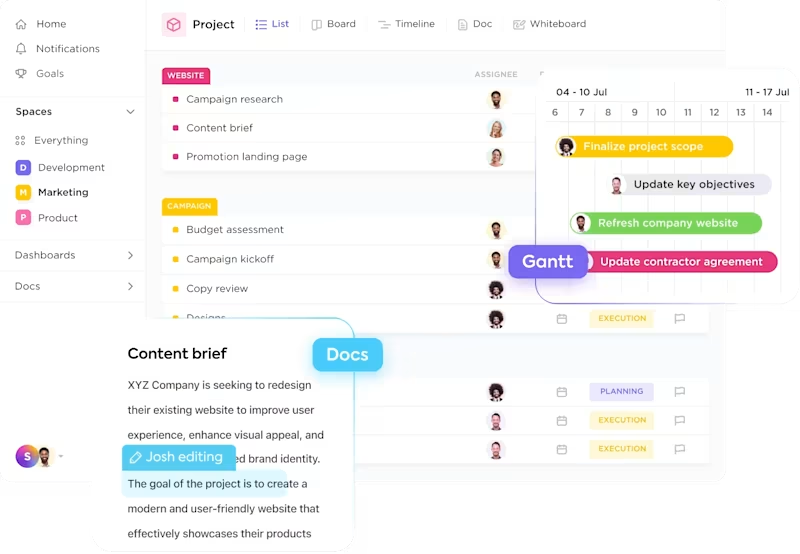
Teams can plan, execute, and measure marketing efforts in one place, ensuring campaigns run smoothly and deliver real impact.
Learn more about how Smokeball uses ClickUp to accelerate their growth 👇
ClickUp’s task and project management features allow businesses to efficiently organize, prioritize, and execute new growth initiatives. With ClickUp Tasks, your team can break down ambitious growth initiatives into clear, actionable steps. They let you assign action items, set deadlines, and track progress without losing sight of the bigger picture.
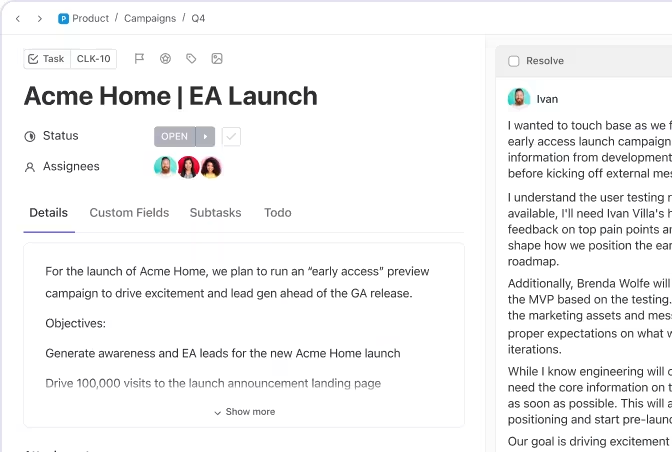
ClickUp’s Project Management features take this a step further by connecting every task to an overarching goal, such as improving revenue or profit numbers, breaking into a new market, or outpacing competitors. They help you map out every stage of a growth initiative, from ideation to execution.
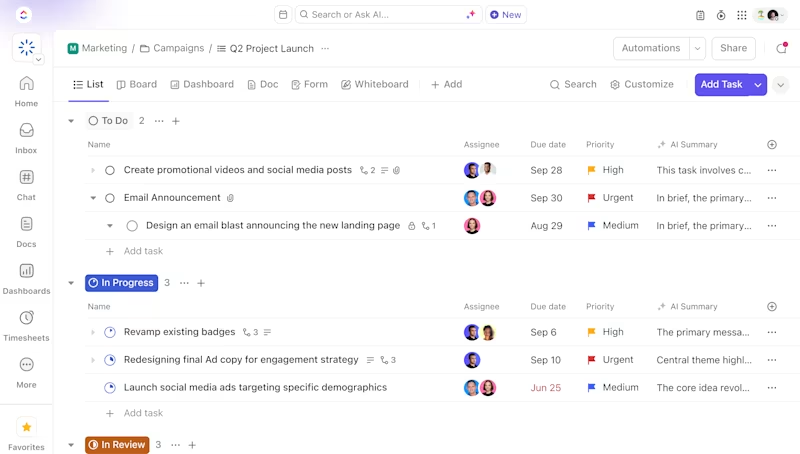
Need to launch a new product-led growth strategy for SaaS, expand market share, or optimize an internal process? Customizable project management tools—like Gantt charts, Kanban boards, and resource allocation, workload balancing, time-tracking, and reporting—make it easy to stay organized, track dependencies, and keep initiatives on schedule.
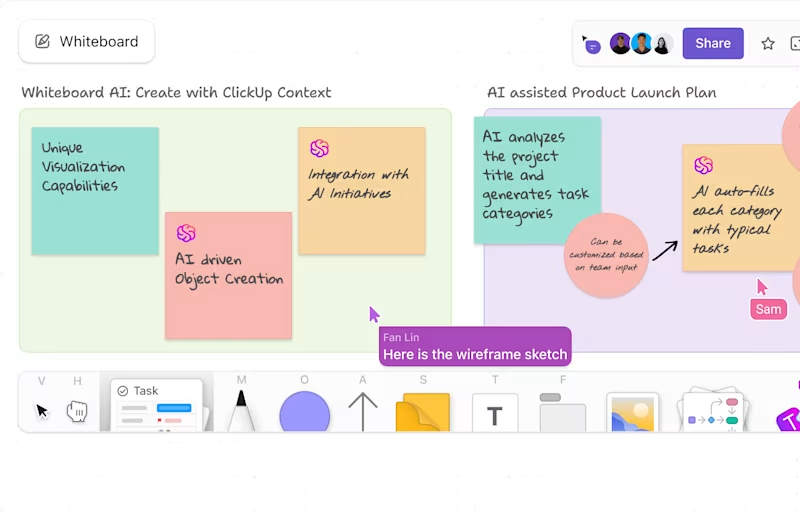
Need to brainstorm strategies or map out a new campaign? ClickUp Whiteboards offers an interactive space where ideas flow visually.
Teams can visually map out ideas using drawings, sticky notes, shapes, and text formatting while collaborating in real time. This feature is particularly handy for distributed teams working on creative solutions or long-term growth strategies.
The best part is that Whiteboards seamlessly integrates into workflows by allowing objects created during brainstorming sessions to be converted into actionable Tasks.
💡Pro Tip: Effectively executing growth campaigns is a critical avenue for pipeline and revenue generation. But that execution is often slowed down by poorly executed handoffs, approvals, spotty communication, and content bottlenecks. ClickUp removes those barriers, allowing you to execute seamlessly and repeatedly. Watch how👇🏼
Additionally, teams can use ClickUp’s SMART Goals Template to set Specific, Measurable, Attainable, Relevant, and Time-bound objectives, breaking down larger growth strategies into actionable targets.
It keeps everything aligned, making tracking progress in real time easy. Teams are clear and accountable throughout the process, whether it’s increasing revenue, strategizing customer acquisition, or scaling operations.
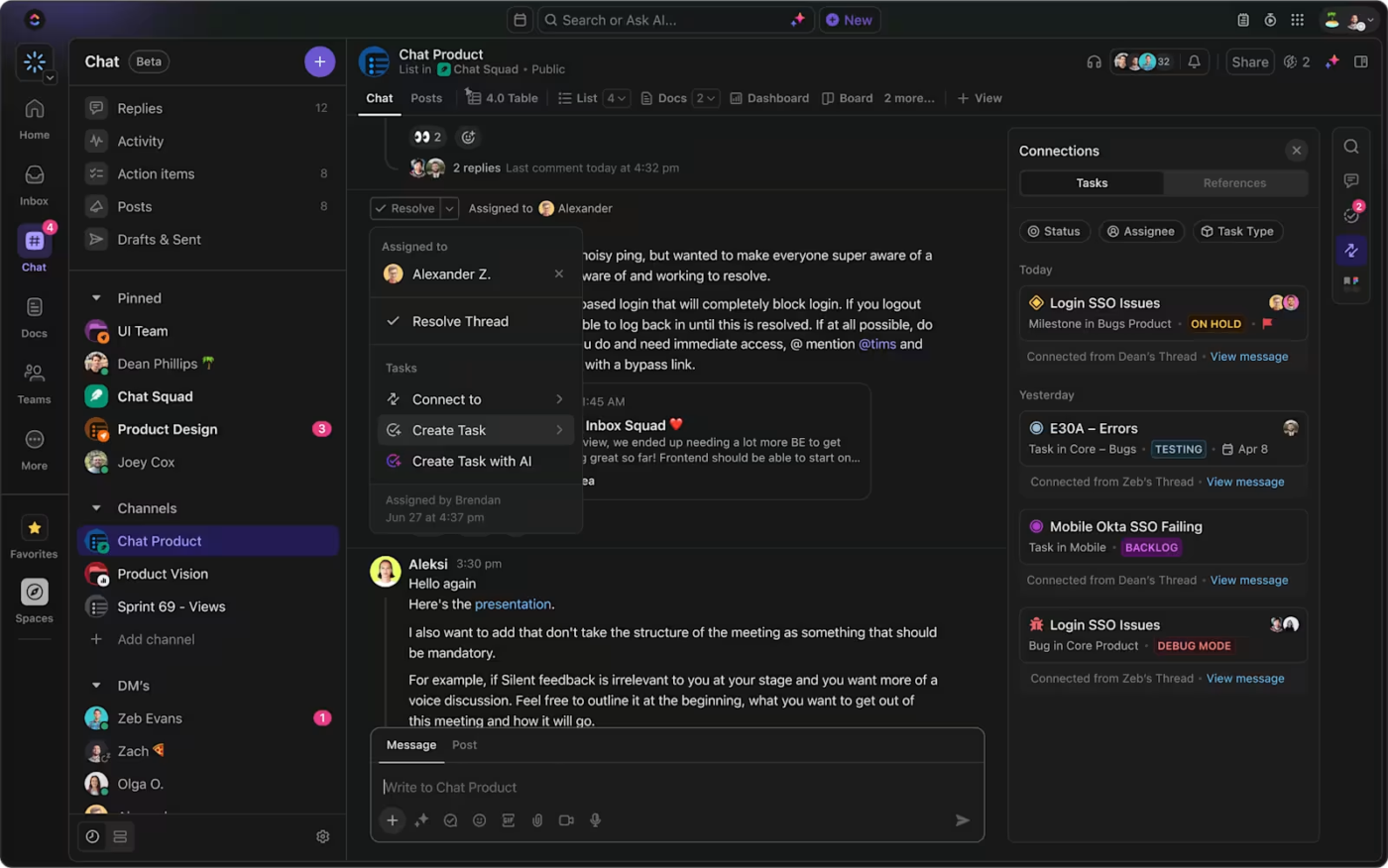
But execution isn’t just about planning—it’s equally about smooth collaboration. Growth initiatives involve multiple teams. And if communication isn’t clear, progress stalls. ClickUp Chat shines at this. It helps you easily send messages to project groups and connect with your team members one-on-one, async and in real time.
You’ve also got contextual threads within ClickUp Tasks and Docs, Assigned Comments for actionable feedback, and dedicated ClickUp Chat channels for focused discussions, so your growth initiatives are never impeded by broken communication.
These streamline communication, eliminate the need for external tools, and ensure that team members stay aligned on growth initiatives.
👀 Did You Know? Leading organizations—like Yggdrasil Gaming—have witnessed 30% business growth since adopting ClickUp.
Of course, none of this matters if you can’t track what’s working. ClickUp Dashboards provide real-time insights into key metrics like lead generation, sales conversions, and campaign performance.
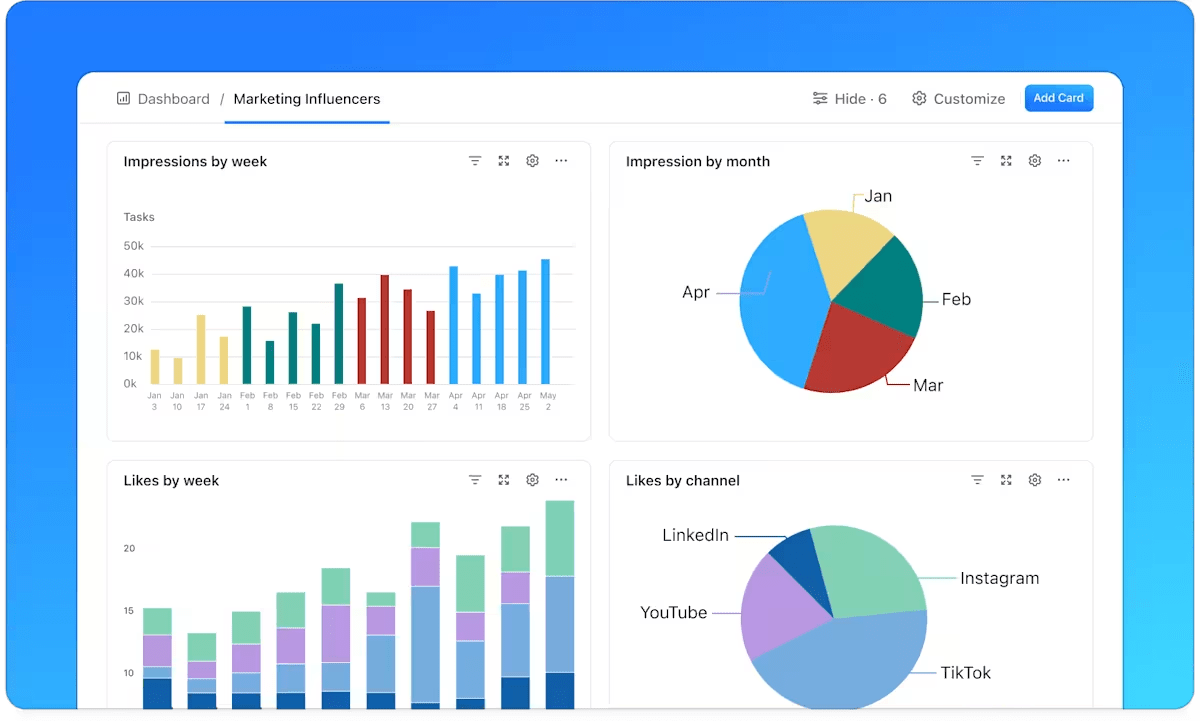
Custom dashboards on the platform empower teams to make informed adjustments to strategies as needed, ensuring alignment with business goals. They even help generate content ideas, optimize messaging, and speed up workflows.
📌 Success story: Finastra’s GTM overhaul
Finastra’s 120-person marketing team was juggling plans across MS Teams, SharePoint, and local files—slowing campaigns and muddying insights. ClickUp brought everything together in one place, streamlining GTM planning, boosting real-time visibility, and cutting down on slide-heavy meetings. The result? Faster execution and smarter decisions across the board.
Communicating the status and performance of our global and regional marketing campaigns to our business units was far from optimal. With our new Dashboards, we’re saving time and our stakeholders have real-time access to the information they need, whenever they need it.
Of course, you can automate many parts of the entire process with ClickUp’s AI features, which step in as your intelligent, autonomous teammates, executing work for you even as you sleep.
They empower teams to work smarter and direct most of their time and energy into strategic work, making it easier to implement and scale growth initiatives across the organization.
With ClickUp Brain, the world’s most contextual and complete work AI, you can:
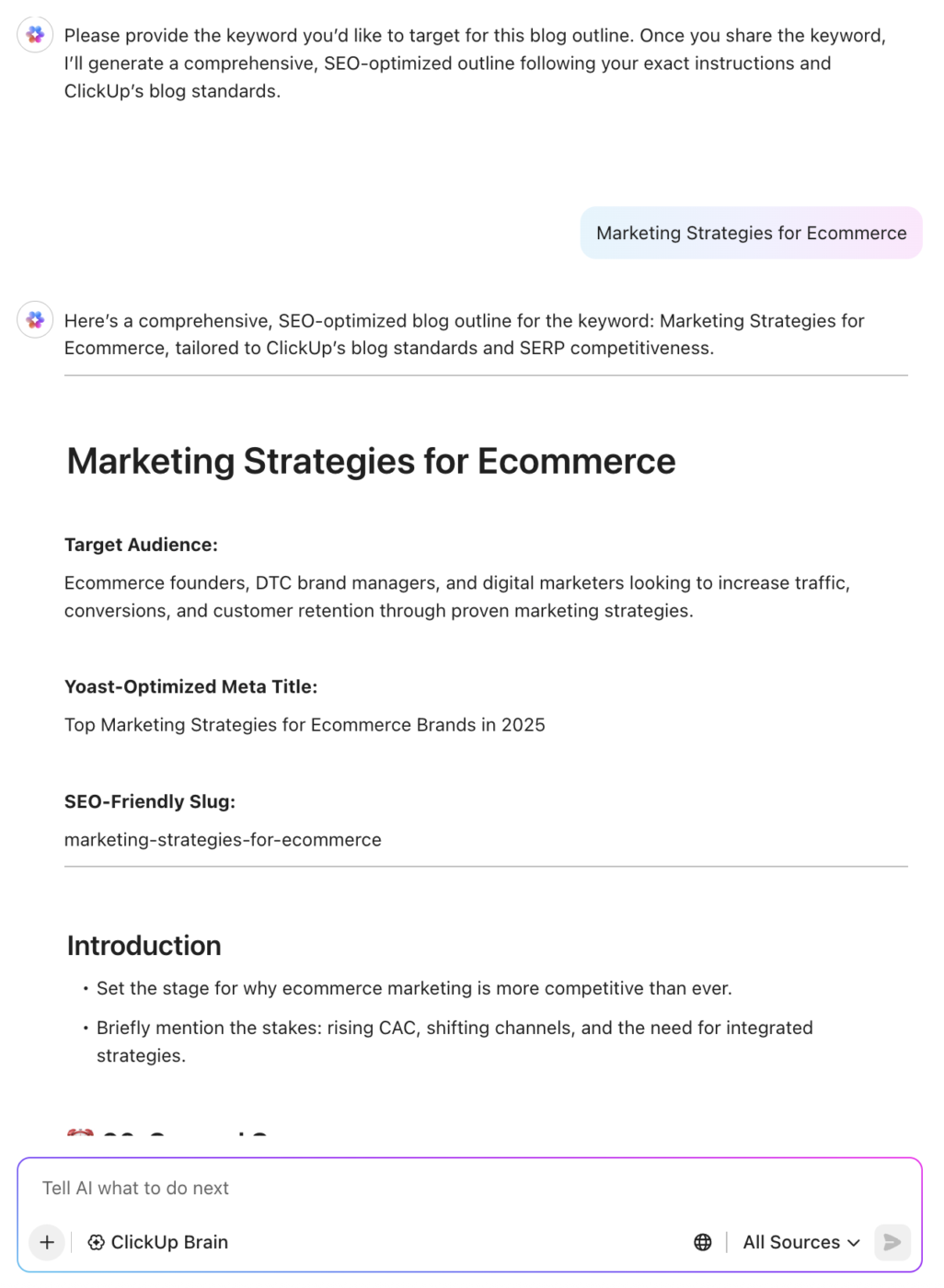
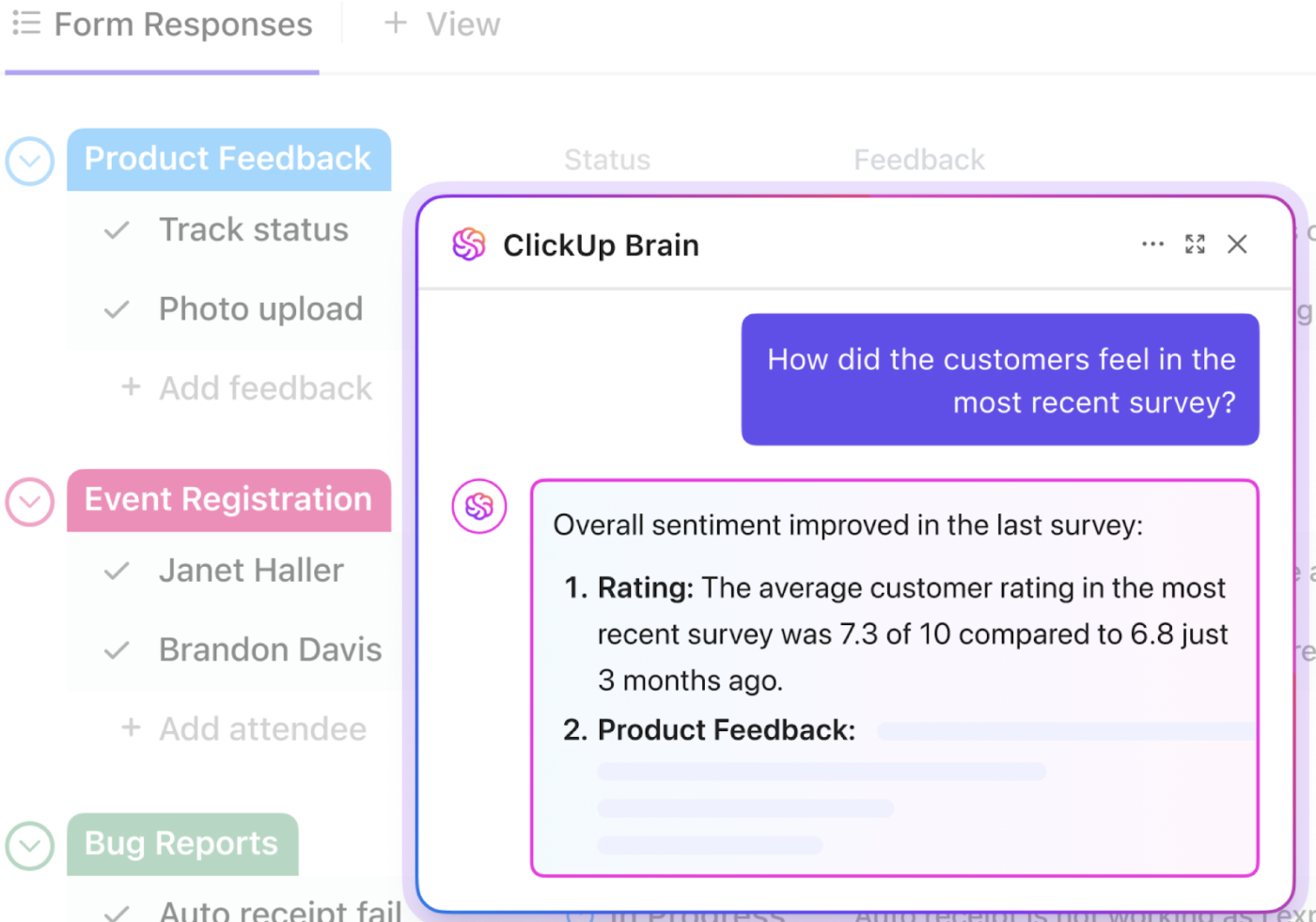
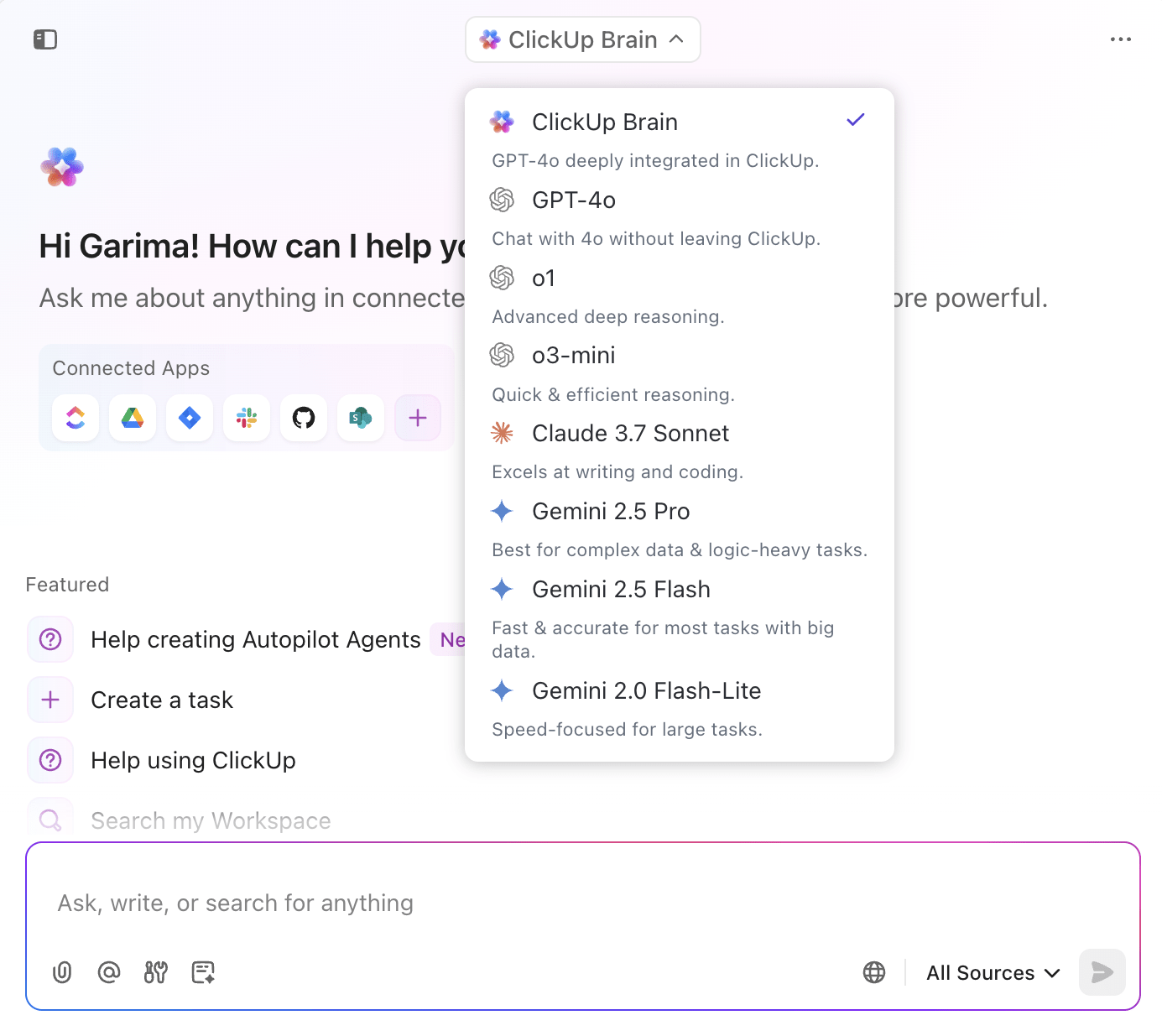
You can also set up custom AI Agents in ClickUp to handle routine processes and trigger workflows.
Think of them as your 24/7 growth operators: they can pull campaign data, update dashboards, send performance summaries, or even trigger new experiments when targets are met. Whether it’s refreshing your pipeline metrics every morning or kicking off a new product launch workflow, these agents keep your growth initiatives running smoothly and autonomously—so your team can focus on strategy, not setup.
💡 Pro Tip: Level up your growth operations with ClickUp Brain MAX—your desktop AI companion that connects every tool, doc, and data source across your ClickUp workspace and connected apps.
Instead of switching between analytics dashboards, campaign trackers, and content docs, Brain MAX lets you pull insights, surface trends, and even act on them—all with one command.
Here’s a sample of how ClickUp Brain MAX can add value to your initiatives👇
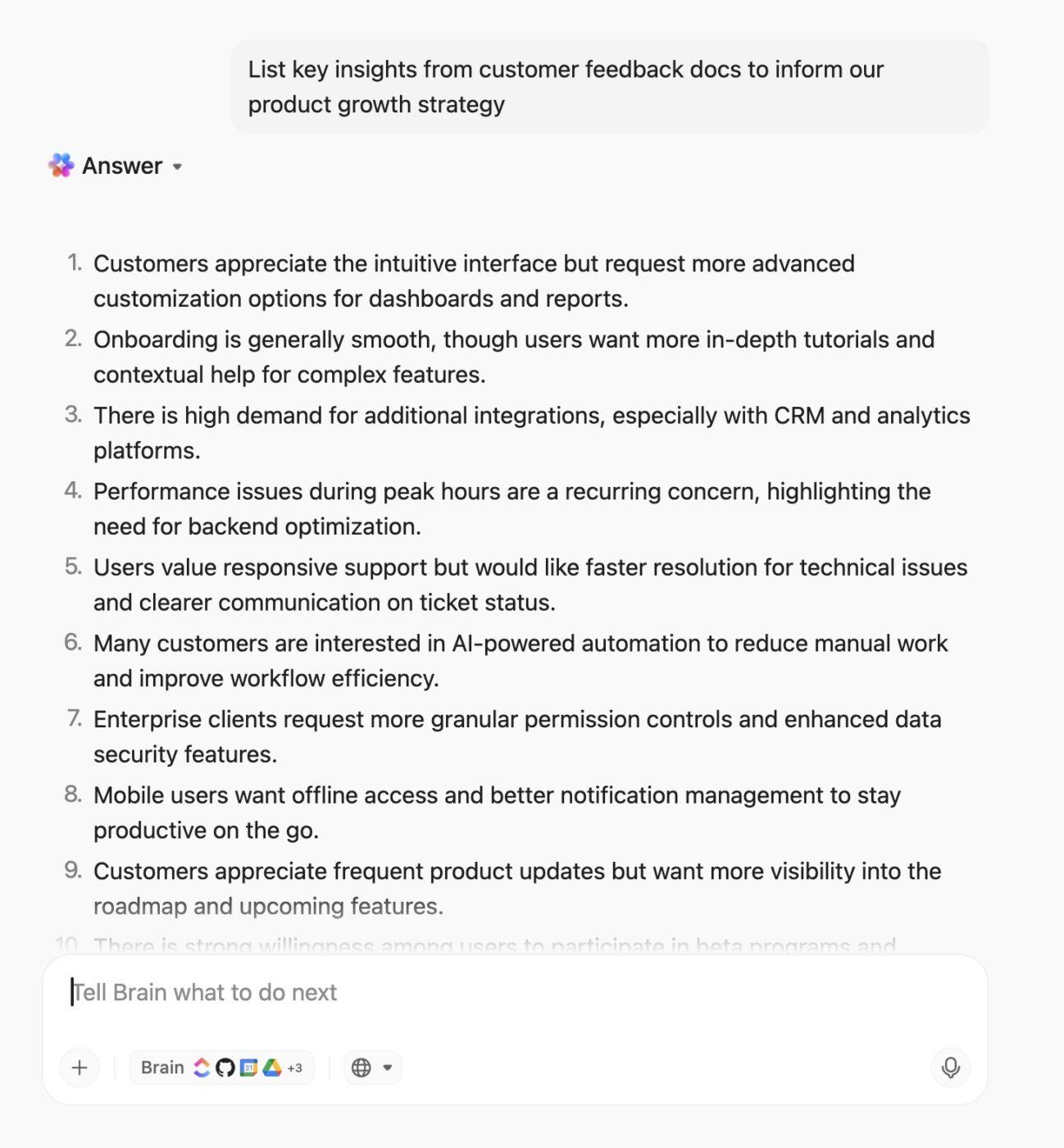
The bottom line? ClickUp’s Contextual AI turns your ClickUp workspace into a live command center for growth—where every decision, update, and next step is just one prompt away!
Even the best growth initiatives can face setbacks, whether it’s poor execution, misalignment across teams, or a lack of clear metrics to measure success.
Here are some of the most common obstacles and how to overcome them:
| Challenge | Solution |
| Unclear goals and misaligned priorities | Set clear, measurable objectives tied to business outcomes. Ensure every team member understands their role and hold regular check-ins to maintain alignment |
| Execution bottlenecks and slow implementation | Break down large initiatives into smaller, actionable steps. Assign ownership, set deadlines, and streamline workflows to avoid unnecessary delays |
| Lack of data-driven decision-making | Identify key performance indicators (KPIs) for each growth initiative. Track and analyze data consistently to refine strategies in real time |
| Poor customer retention and engagement | Gather existing customer feedback, improve onboarding, and offer proactive support. Use personalization, loyalty programs, and community engagement to boost retention |
| Limited resources and budget constraints | Focus on high-impact, low-cost strategies first. Leverage automation and partnerships to scale efficiently before investing in higher-cost initiatives |
| Resistance to change within teams | Communicate the benefits of new initiatives clearly. Involve teams early in the process and provide training or support to ease transitions |
Scaling a business doesn’t mean doing everything. It means picking what works—and doing it really well.
The challenge is figuring out which initiative will have the biggest impact. With the right system, you can plan, track, and execute your growth strategy and become a business leader.
Here’s where ClickUp can make a massive difference. From setting goals and managing Tasks to tracking real-time progress with Dashboards, ClickUp helps teams turn growth strategies into reality—all within one platform.
Whether you’re launching a new product, simplifying operations, or scaling marketing efforts, ClickUp can keep everything organized, efficient, and aligned.
Ready to put your growth plans into action? Sign up for ClickUp for free and start scaling today!
© 2025 ClickUp